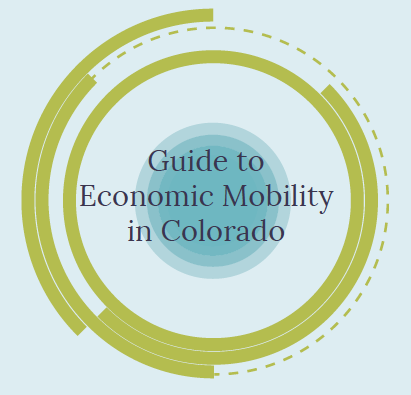Economic Mobility in Colorado

The Bell Policy Center’s Guide to Economic Mobility in Colorado offers a comprehensive look at the barriers and opportunities communities face as we work to ensure economic mobility for every Coloradan.
After a year of conversations across the state and intensive research, it’s clear to us that despite Colorado’s overarching economic growth, too many Coloradans are not feeling the benefits of our state’s exceptional prosperity. Many of our fellow citizens feel stuck, and see the American Dream as elusive. Even still, there is pride in and optimism about the Colorado way of life.
This guide explores how the forces of shifting demographics, economic inequality, shrinking public investments, and technological change make economic mobility a steep uphill climb. Despite the challenges these forces present, we continue to believe successful use of policy levers in areas like education, health, housing, and labor and employment law can make that climb easier. Throughout this guide, we take measure of how we use those levers and offer ideas for how we can do better.
Our hope is the information, analysis, and recommendations offered here fuel a robust conversation about economic mobility in Colorado. We recognize there will be diverse perspectives on this information and welcome an open conversation to discuss them.
The Bell Policy Center believes it’s within our power to raise the economic floor, build a diverse and thriving middle class, and embrace innovation in Colorado. To do that, we need the facts and ideas to change our course. We’re confident this guide provides just that.
Key Takeaways About Economic Mobility in Colorado
- Colorado is growing older and more diverse. Notably, Hispanics will become a third of Colorado’s population by 2050. However, they will make up more than 60 percent of new people in the workforce by that time. This underscores the importance of closing equity gaps today.
- Colorado’s overall economic recovery stands out, but gains have been uneven throughout the state. Distressed communities persist both in rural and metro areas and Colorado is adding more low-wage jobs than any other. When adjusted for inflation, average weekly wages have only risen $33 since 2000.
- Low investment in public programs hits Colorado families hard. At 3.7 percent, Colorado is investing a historically low proportion of its General Fund into these services.
- Automation puts Colorado at a critical place over the next two decades. Changes in technology likely will affect about 477,000 Colorado workers. Most of these are workers in low-paying jobs requiring few skills.
- High-quality early childhood education has become too expensive for many families. The Colorado Preschool Program (CPP), which was designed to help with costs for low-income families, is only serving 20 percent of Colorado’s 3- and 4-year-olds.
- Our changing workforce means we should pay greater attention to postsecondary education. We must further educate the 9 percent of Coloradans who haven’t completed a high school diploma or its equivalent. We need affordable approaches to help the more than 30 percent of undergraduates age 25 and older. Colorado’s outstanding student loan debt now totals $24.75 billion. The state’s for-profit students face even higher average debt than other students.
- Combined two-generation approaches to early childhood and postsecondary challenges show enormous potential for cost-effective ways to improve outcomes.
- A historic number of Coloradans now have health insurance — at 6.5 percent, Colorado’s uninsured rate is down significantly from the 18 percent it was 10 years ago, but crucial pressure points still exist. A new study of 23 states finds Coloradans spend the most on out-of-pocket costs.
- Lack of affordable housing is a top concern for Coloradans. A household must make $21.97 to afford rent and utilities in Colorado, but the average renter wage is only $17.13. Nearly half of all Colorado renters are cost burdened, with an additional 24 percent severely cost burdened.
- In the workplace, updating wage, benefits, and worker protection practices would have positive implications for our state. Gender pay equity could mean the state’s poverty rate from 5.6 percent to 2.8 percent. Implementing the Obama administration’s proposed overtime eligibility changes would benefit 248,000 salaried Coloradans, especially female, black, and Hispanic workers.
- Child care poses a huge challenge for working parents, as 64 percent of Colorado children under the age of six live in a home where all primary caregivers work, but Colorado’s Child Care Assistance Program (CCCAP) only serves 13 percent of eligible families.
- Colorado risks future public funding liabilities if it doesn’t address the high costs of long-term care, the lack of options to save for this expense, and retirement savings in the state. Care for seniors is among the biggest cost drivers in Medicaid and is projected to grow, and half of Coloradans don’t have access to retirement plans at work.
